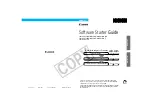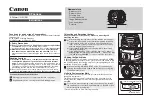
BOBCAT HD-SDI
Hardware User’s Manual
Imperx, Inc.
Rev. 1.4
6421 Congress Ave.
6/2/2014
Boca Raton, FL 33487
+1 (561) 989-0006
58 of 175
2.14.1.
Static Pixel Correction
Static Defective and Hot pixel correction works with predetermined and
preloaded Defective and Hot pixel maps. During factory final testing, our
manufacturing engineers run a program specially designed to identify these
‘defective’ and “hot” pixels. The program creates a map file which lists the
coordinates (i.e. row and column) of every defective pixel. This file, called the
Defect Pixel Map, is then downloaded into the camera’s non-volatile memory.
Users may wish, however, to create and to upload their own DPM file because of
the uniqueness of their operating environment or camera use.
When ‘Defective
Pixel Correction’ is enabled, the camera will compare each pixel’s coordinates
with entries in the ‘defect’ map. If a match is found, then the camera will
‘correct’ the defective pixel. When ‘Hot Pixel Correction’ is enabled, the
camera will compare each pixel’s coordinates with entries in the ‘defect’ map.
If a match is found, then the camera will ‘correct’ the hot pixel. The
"Defective/Hot Pixel Map" can be displayed upon user request.
2.14.2.
Dynamic Pixel Correction
Dynamic pixel correction works without preloaded pixel maps. When this
option is enabled, the camera determines which pixel needs correction and
performs the correction automatically. Static and Dynamic “Defective Pixel
Correction” and “Hot Pixel Correction” can be enabled independently or
simultaneously.
2.15.
FLAT FIELD CORRECTION
A CCD imager is composed of a two dimensional array of light sensitive pixels. Each
pixel within the array, however, has its own unique light sensitivity characteristics.
Most of the deviation is due to the difference in the angle of incidence and to charge
transport artifacts. This artifact is called ‘Shading’ and in normal camera operation
should be removed. The process by which a CCD camera is calibrated for shading is
known as ‘Flat Field Correction’. Refer to Figures 2.16 and 2.17 for images acquired
before and after Flat Field Correction.
This feature is available as a standard feature
only for cameras with 2/3” optical format or bigger
.
The BOBCAT series of cameras incorporate a Flat Field Correction mechanism. The
Flat Field Correction mechanism measures the response of each pixel in the CCD
array to illumination and is used to correct for any variation in illumination over the
field of the array. The optical system most likely introduces some variation in the
illumination pattern over the field of the array. The flat field correction process
compensates for uneven illumination, if that illumination is a stable characteristic of
each object exposure.
















































